IRF-1 regulates alternative mRNA splicing of carcinoembryonic antigen-related cell adhesion molecule 1 (CEACAM1) in breast epithelial cells generating an immunoreceptor tyrosine-based inhibition motif (ITIM) containing isoform
- PMID: 24650050
- PMCID: PMC4113144
- DOI: 10.1186/1476-4598-13-64
IRF-1 regulates alternative mRNA splicing of carcinoembryonic antigen-related cell adhesion molecule 1 (CEACAM1) in breast epithelial cells generating an immunoreceptor tyrosine-based inhibition motif (ITIM) containing isoform
Abstract
Background: Interferon regulatory factor-1 (IRF-1) is a master regulator of IFN-γ induced gene transcription. Previously we have shown that IRF-1 transcriptionally induces CEACAM1 via an ISRE (Interferon-Stimulated Response Element) in its promoter. CEACAM1 pre-mRNA undergoes extensive alternative splicing (AS) generating isoforms to produce either a short (S) cytoplasmic domain expressed primarily in epithelial cells or as an ITIM-containing long (L) isoform in immune cells.
Methods: The transcriptional and molecular mechanism of CEACAM1 minigenes AS containing promoter ISREs mutations in the breast epithelial, MDA-MB-468, cell line was detected using flow cytometry. In addition, transcriptome sequencing was utilized to determine whether IRF-1 could direct the AS of other genes as well. Tumor xenografts were used to evaluate CEACAM1 isoform expression on the leading edge of breast tumor cells.
Results: In the present study, we provide evidence that CEACAM1's promoter and variable exon 7 cross-talk allowing IRF-1 to direct AS events. Transcriptome sequencing shows that IRF-1 can also induce the global AS of genes involved in regulation of growth and differentiation as well as genes of the cytokine family. Furthermore, MDA-MB-468 cells grown as tumor xenografts exhibit an AS switch to the L-isoform of CEACAM1, demonstrating that an in vivo inflammatory milieu is also capable of generating the AS switch, similar to that found in human breast cancers Mol Cancer 7:46, 2008.
Conclusions: The novel AS regulatory activities attributed to IRF-1 indicate that the IFN-γ response involves a global change in both gene transcription and AS in breast epithelial cells.
Figures
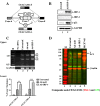
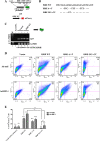

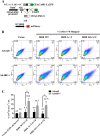
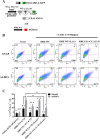
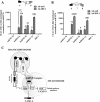



Similar articles
-
Interferon regulatory factor 1 and a variant of heterogeneous nuclear ribonucleoprotein L coordinately silence the gene for adhesion protein CEACAM1.J Biol Chem. 2018 Jun 15;293(24):9277-9291. doi: 10.1074/jbc.RA117.001507. Epub 2018 May 2. J Biol Chem. 2018. PMID: 29720400 Free PMC article.
-
Regulation of CEACAM1 transcription in human breast epithelial cells.BMC Mol Biol. 2010 Nov 4;11:79. doi: 10.1186/1471-2199-11-79. BMC Mol Biol. 2010. PMID: 21050451 Free PMC article.
-
Mechanistic control of carcinoembryonic antigen-related cell adhesion molecule-1 (CEACAM1) splice isoforms by the heterogeneous nuclear ribonuclear proteins hnRNP L, hnRNP A1, and hnRNP M.J Biol Chem. 2011 May 6;286(18):16039-51. doi: 10.1074/jbc.M110.204057. Epub 2011 Mar 11. J Biol Chem. 2011. PMID: 21398516 Free PMC article.
-
Mechanism and function of CEACAM1 splice isoforms.Eur J Clin Invest. 2024 Dec;54 Suppl 2(Suppl 2):e14350. doi: 10.1111/eci.14350. Eur J Clin Invest. 2024. PMID: 39674874 Free PMC article. Review.
-
[CEACAM1 as a central modulator of metabolism, tumor progression, angiogenesis and immunity].Med Sci (Paris). 2009 Mar;25(3):247-52. doi: 10.1051/medsci/2009253247. Med Sci (Paris). 2009. PMID: 19361387 Review. French.
Cited by
-
Interferon regulatory factor 1 and a variant of heterogeneous nuclear ribonucleoprotein L coordinately silence the gene for adhesion protein CEACAM1.J Biol Chem. 2018 Jun 15;293(24):9277-9291. doi: 10.1074/jbc.RA117.001507. Epub 2018 May 2. J Biol Chem. 2018. PMID: 29720400 Free PMC article.
-
Extensive Alternative Splicing Patterns in Systemic Lupus Erythematosus Highlight Sexual Differences.Cells. 2023 Nov 22;12(23):2678. doi: 10.3390/cells12232678. Cells. 2023. PMID: 38067106 Free PMC article.
-
Heterogeneity of hepatocyte dynamics restores liver architecture after chemical, physical or viral damage.Nat Commun. 2024 Feb 10;15(1):1247. doi: 10.1038/s41467-024-45439-0. Nat Commun. 2024. PMID: 38341404 Free PMC article.
-
CEACAM expression in an in-vitro prostatitis model.Front Immunol. 2023 Aug 25;14:1236343. doi: 10.3389/fimmu.2023.1236343. eCollection 2023. Front Immunol. 2023. PMID: 37691945 Free PMC article.
-
Genetic evidence for causal effects of inflammatory protein factors on breast cancer.Discov Oncol. 2025 Aug 7;16(1):1490. doi: 10.1007/s12672-025-03370-w. Discov Oncol. 2025. PMID: 40773112 Free PMC article.
References
-
- Schoenborn JR, Wilson CB. Regulation of interferon-gamma during innate and adaptive immune responses. Adv Immunol. 2007;96:41–101. - PubMed
MeSH terms
Substances
Grants and funding
LinkOut - more resources
Full Text Sources
Other Literature Sources
Molecular Biology Databases
Research Materials
Miscellaneous

